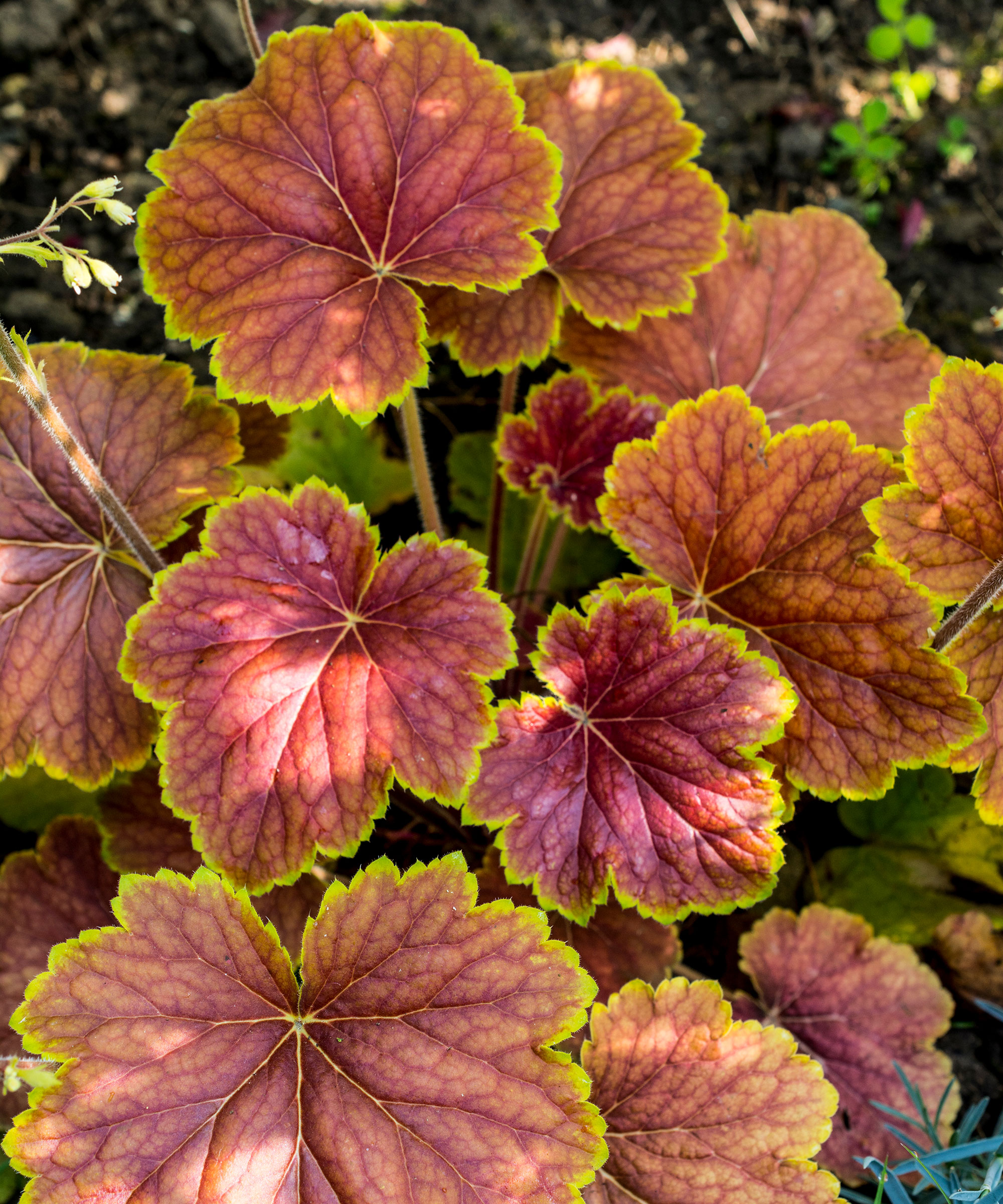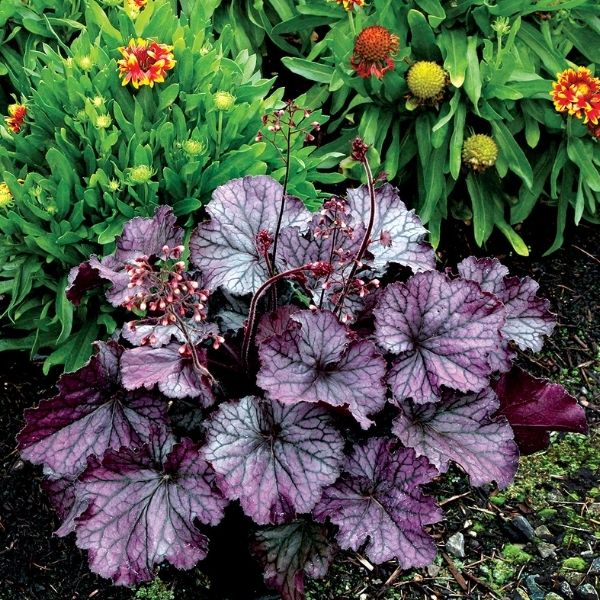Experts warn not to cut back coral bells in the fall – it can risk the plant’s long-term health
Don’t take the gamble of cutting back coral bells for winter – wait util spring no matter your climate


Coral bells, the common name for heucheras, are attractive hardy perennials. With a vast array of colors, sizes, and leaf shapes, coral bells are hugely popular foliage or ground cover plants for shady areas.
The plants are native to North America and can be evergreen in many climates to put on a fantastic display of gorgeous foliage year-round, complimented by tiny flowers in the summer.
Cutting back plants is important when growing heuchera to keep them looking at their best and developing healthy growth during the season. But when is the best time to trim and should you cut back coral bells in the fall? To answer this question, we hear from some plant experts about whether cutting back heuchera for winter is a good idea.

Coral bells come in a huge range of foliage colors and shapes
Should heuchera be cut back for winter?
Whether you refer to the plants as coral bells, heuchera, coral root, or alumroot - as they are perennial plants known by many names - knowing when to cut back any of the hundreds of heuchera varieties you can pick between is important in ensuring their long-term survival. To cut back in the fall or not, that is the question.
Do you cut back coral bells in the fall?

Coral bells keep their colorful leaves through fall and winter in many climates
Coral bells are hardy in US hardiness zones 4-9 and easy perennials to grow. They are very versatile and suitable for a wide range of backyard ideas as heuchera is tolerant of many different soil types, light conditions, and drought. Coral bells are native North American plants that will happily grow as evergreen ground cover plants in warmer US hardiness zones.
Where heuchera plants are evergreen year-round, cutting plants back in fall would rob you of color during the leaner months from late fall to early spring. Chuck Pavlich, director of new product development with Terra Nova Nurseries, warns that cutting back coral bells in the fall can put the plant at unnecessary risk and impact future displays. He warns: ‘Unnecessarily removing perfectly good foliage reduces the amount of food that leaves make for the plant that sustains it during winter.’
Yellow leaves and diseased growth can be removed in the fall. For example, any leaves showing signs of heuchera rust must be removed and disposed of and never used to make compost. Old flowering stems can also be trimmed back with clean and sharp pruning shears, however, leave all healthy foliage in place for interest in a winter garden.
Design expertise in your inbox – from inspiring decorating ideas and beautiful celebrity homes to practical gardening advice and shopping round-ups.
So, the next logical question is should coral bells be cut back in the fall in colder climates where they die back? The answer to that is also no. Even in colder climates, where the leaves will die back due to winter colds, frosts, and damaging winds, the old foliage still offers benefits.
‘Removing the leaves exposes the crown of the plant, typically the most tender part,’ warns Chuck Pavlich. ‘Even leaves that have dried on the plant help guard the crown.’
Tammy Sons, the founder of TN Nursery, echoes those words of advice when it comes to coral bells fall pruning. She warns: ‘You should not cut back coral bells in the fall. You should wait until springtime to tidy up the plant. Leave the foliage on coral bells for winter protection. The extra foliage will protect the crown of the plant in harsh winter conditions.’
Even if your heuchera looks sad and tired in the fall, resist any urge you may have to prune as cutting back coral bells for winter is a pruning mistake that will risk the plant’s long-term health.
If your climate is so cold that it kills the leaves, it also has the potential to cause irreversible damage to the crown of the heuchera. The dead foliage may not look pretty, but it is doing an important job.
Instead, add cutting back heuchera to your spring gardening checklist. The plant will respond quickly to the pruning and send out a new flush of showy colorful leaves.

As Director of New Product Development at Terra Nova Nurseries, Chuck is responsible for new ideas for the breeders as well as overseeing the breeding process and shepherding new products to the world perennial market. Terra Nova Nurseries has introduced numerous new selections of Heucherella - hybrids of heucheras and tiarellas - along with other annuals and perennials.

Tammy Sons has decades of experience in horticulture. She is the founder and CEO of TN Nursery, which is recognized as the go-to place for some of the world's largest brands.
FAQs
Can I divide heuchera in the fall?
If you have a favorite clump and want more, you can think about dividing coral bells. If you are wondering when to divide plants, the best time would be in spring. This timing means each clump has many months to establish in its new home. If you divide heuchera in the fall, it has less time to put down roots before winter.
How do you take care of heuchera in the fall?
When putting together a fall gardening checklist, heucheras require only a little attention. Remove old, yellow, or diseased foliage and cut back the old flower stems. Also consider mulching around plants to protect the roots from winter colds, smother weeds, and help retain moisture in the soil.
Save pruning back heuchera for spring, but there are some perennials to cut back in the fall rather than wait till next year. As pests and diseases can overwinter, pruning susceptible perennials helps to keep them healthy from one growing season to another. The likes of phlox, hostas, and irises are among those popular flower bed perennials that will benefit from being cut back after the first frosts.

Drew has worked as a writer since 2008 and was also a professional gardener for many years. As a trained horticulturist, he worked in prestigious historic gardens, including Hanbury Hall and the world-famous Hidcote Manor Garden. He also spent time as a specialist kitchen gardener at Soho Farmhouse and Netherby Hall, where he grew vegetables, fruit, herbs, and cut flowers for restaurants. Drew has written for numerous print and online publications and is an allotment holder and garden blogger. He is shortlisted for the Digital Gardening Writer of the Year at the 2025 Garden Media Guild Awards.
